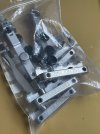OrganicZed
Fractal Fanatic
I can't advise enough to not use a T'No , They suck tone and don't work well. They get loose and clunk or interfere with the zero point when floating. The down bend only stop can't be engaged properly without tightening the springs slightly but then you can't disengage it. Basically it is a POS. I take more off than anything else with them.
I'm kind of baffled as to why Guthrie Govan has the tremol-no on his signature guitar. They seem like a huge compromise for a situation that simply calls for having two guitars. That said, he obviously makes them work for what he needs.

